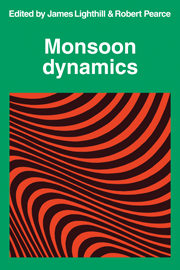Book contents
- Frontmatter
- Contents
- Contributors
- Editors' preface
- Keynote address to the 1977 Symposium SIR JAMES LIGHTHILL
- Part I The large-scale climatology of the tropical atmosphere
- 1 Teleconnections of rainfall anomalies in the tropics and subtropics
- 2 Northern summer planetary-scale monsoons during drought and normal rainfall months
- 3 The annual oscillation of the tropospheric temperature in the northern hemisphere
- 4 Summer mean energetics for standing and transient eddies in the wavenumber domain
- 5 Monitoring the monsoon outflow from geosynchronous satellite data
- 6 Predictability of monsoons
- 7 A review of general-circulation model experiments on the Indian monsoon
- 8 Simulation of the Asian summer monsoon by an 11-layer general-circulation model
- 9 Analysis of monsoonal quasi-stationary systems as revealed in a real-data prediction experiment
- 10 A model of the seasonally varying planetary-scale monsoon
- 11 Wave interactions in the equatorial atmosphere – an analytical Study
- Part II The summer monsoon over the Indian subcontinent and East Africa
- Part III The physics and dynamics of the Indian Ocean during the summer monsoon
- Part IV Some important mathematical modelling techniques
- Part V Storm surges and flood forecasting
- Index
8 - Simulation of the Asian summer monsoon by an 11-layer general-circulation model
Published online by Cambridge University Press: 05 November 2011
- Frontmatter
- Contents
- Contributors
- Editors' preface
- Keynote address to the 1977 Symposium SIR JAMES LIGHTHILL
- Part I The large-scale climatology of the tropical atmosphere
- 1 Teleconnections of rainfall anomalies in the tropics and subtropics
- 2 Northern summer planetary-scale monsoons during drought and normal rainfall months
- 3 The annual oscillation of the tropospheric temperature in the northern hemisphere
- 4 Summer mean energetics for standing and transient eddies in the wavenumber domain
- 5 Monitoring the monsoon outflow from geosynchronous satellite data
- 6 Predictability of monsoons
- 7 A review of general-circulation model experiments on the Indian monsoon
- 8 Simulation of the Asian summer monsoon by an 11-layer general-circulation model
- 9 Analysis of monsoonal quasi-stationary systems as revealed in a real-data prediction experiment
- 10 A model of the seasonally varying planetary-scale monsoon
- 11 Wave interactions in the equatorial atmosphere – an analytical Study
- Part II The summer monsoon over the Indian subcontinent and East Africa
- Part III The physics and dynamics of the Indian Ocean during the summer monsoon
- Part IV Some important mathematical modelling techniques
- Part V Storm surges and flood forecasting
- Index
Summary
Gilchrist (1977) has described the simulation of the Asian summer monsoon by a 5-layer general-circulation model and has compared its results with those of other models that have been published. The diabatic heat sources and sinks for the model in the monsoon region were considered, since both on general theoretical grounds and as a matter of observation they are expected to be important in creating the monsoon circulation. From the simulation, it appeared that the surface-pressure trough and many features of the overall flow were related particularly to the low-level sensible heat input to the boundary layer.
Attention was drawn to certain shortcomings in the 5-layer model simulation. Primarily they were:
(i) The monsoon surface-pressure trough was weaker than indicated by climatology as was the near-surface flow, and the position of the surface trough was in error in being over the Indian continent rather than over the Bay of Bengal.
(ii) The rainfall distribution was poor in a number of respects, but particularly in failing to give adequate amounts of rain over the Ganges basin and the southern slopes of the Himalayas.
These errors were shared in substantial measure by the other general-circulation models considered.
In this chapter, the southwest monsoon simulation of the 5-layer model is compared with that of an 11-layer general-circulation model, which, like the simpler model, was developed in the Meteorological Office.
Brief description of the models
The formulation of the 5-layer model is given in Corby et al. (1977). It has an irregular grid-mesh on the sphere designed to achieve a quasi-constant mesh-length of approximately 330 km.
Information
- Type
- Chapter
- Information
- Monsoon Dynamics , pp. 131 - 146Publisher: Cambridge University PressPrint publication year: 1981
Accessibility standard: Unknown
- 2
- Cited by
